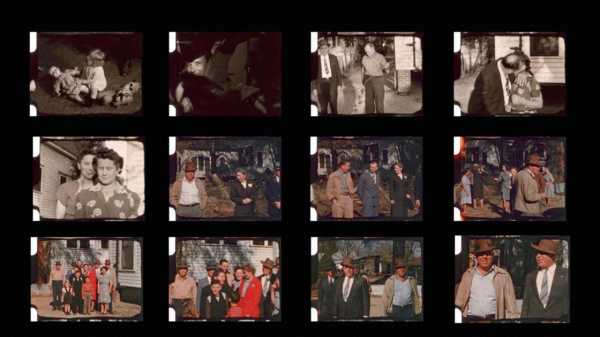
It has taken more than a year for “Did You Wonder Who Fired the Gun?,”
Travis Wilkerson’s great documentary of mourning and reckoning, to reach
general audiences—it premièred at Sundance in January, 2017, and opens
at Film Forum on Wednesday. (I saw it last March, at the True/False Film
Festival, and wrote about it
here at the time.) Though it would have been better for audiences to see it
sooner, some of its most prescient elements now virtually pierce the
screen with real-world affinities. It’s an extraordinary personal
documentary, in which the filmmaker’s first-hand experience is shown to
reach a vast span of politics and a surprising depth of history. The
idea that drives Wilkerson’s film is a powerful one, namely, that
everyone’s private life and family traditions are inseparable from
politics, from ideology, from history—and that the unwillingness to do
the practical, intellectual, and emotional work to find out the
specifics of those connections and to face up to them is both a form of
privilege and a perpetuation of injustice.
Marching in Los Angeles to protest the acquittal, in 2013, of Trayvon
Martin’s killer, George Zimmerman, Wilkerson, who is white, decided to
investigate a bit of ugly family lore: the rumor that his
great-grandfather Samuel Edwin (S. E.) Branch, a grocer in the small
Alabama town of Dothan, killed a black man in the store. Wilkerson’s
project is literally documentary: he pursues the documents that can be
found, including two newspaper clippings, from October, 1946, that
report on the incident—Branch’s shooting of the man, Bill Spann, and
Spann’s death, which resulted in Branch being charged with first-degree
murder. (Branch nonetheless never stood trial.) Wilkerson gets hold of a
copy of Spann’s death certificate, which is specific about the cause of
death (two bullet wounds), Spann’s age (forty-six), the name of his
widow (Lily), and the hospital in which he died, but offers no
information about Spann’s life or his place of burial.
Above all, Wilkerson gathers family photographs of Branch. Especially
interesting are the two extant home movies of Branch, taken by a
“photo-buff” relative: one in black and white, also from October, 1946,
(whether before or after the killing isn’t clear) and one in color,
from 1953. Wilkerson visually analyzes the filmed images of Branch and
compares them, in voice-over discussion, with all that he knows about
Spann (he is particularly mindful of the fact that he has in hand images
of the killer, who’s white, but none of the victim, who’s black) and he
heads to Dothan, which he hasn’t visited in twenty years, to investigate
the story.
Another apt title for the movie could be borrowed from Rithy Panh’s
documentary “The Missing
Picture,”
from 2013. There, Panh, a survivor of the depredations of the Khmer
Rouge in Cambodia in the nineteen-seventies, uses small figurines to
create new images of massacres and slave-labor camps, in lieu of
photographs of these events, which do not exist. Images—the images that
get made and seen and that survive, and the ones that don’t—are at the
heart of “Did You Wonder Who Fired the Gun?” Wilkerson, looking at the
role of a white person taking action against Southern racism, begins the
movie with a brief consideration of Gregory Peck’s performance as the
lawyer Atticus Finch, “a saint,” in the 1962 film of “To Kill a
Mockingbird”—and concludes with a discussion of corresponding images
that don’t exist, of Harper Lee’s earlier version of the book, “Go Set a
Watchman,” in which Atticus is an utterly unsaintly racist.
Wilkerson makes “Did You Wonder Who Fired the Gun?” not to make images
but to search for them. That search involves multiple levels of mystery,
including in the effort to discover the facts surrounding the killing of
Bill Spann by S. E. Branch, and in the effort to find images that bear
physical traces of the victim himself. Many of the most important images
in “Did You Wonder Who Fired the Gun?” are black screens—Wilkerson
blanks out the image only briefly, but notably—because the images that
Wilkerson finds are only substitutes, and inadequate ones, for those
that don’t exist. The ultimate substitution involves Wilkerson’s search
for Spann’s grave. It’s a search that takes him to the nearby town of
Louisville, Alabama, where a white town clerk claims that there’s no
record of the burials of black people from that era but a black official
covertly, and, it seems, fearfully, takes Wilkerson aside and offers to
help. Wilkerson has no images from within the squat, streetside
town hall or of the helpful official—who, moreover, insisted on
anonymity. But he does have images of danger from a nearby town with a
reported Ku Klux Klan presence, where, as he says, he only “wanted to
film trees”—and over an image of those trees he superimposes a shot,
running backward, of Billie Holiday singing what is, in all likelihood,
“Strange Fruit.”
Wilkerson contrasts his images of Branch’s inscribed headstone and
well-tended grave with his images of the place that is somewhere near
what is likely to be Spann’s unmarked burial site. And he contrasts his
own status, as a white maker of those images, with the inability to
trace Spann’s surviving family, even with the help of a private
investigator—and defines those contrasts as the essence of racism.
Images themselves—their existence, their nonexistence, their
implications, their use—are more than the subject of “Did You Wonder Who
Fired the Gun?”; they’re its political focus, its touchstone of
conscience. As the movie advances, Wilkerson fragments the image,
multiplies the image, tints the image blood-red, suggesting—as his
investigation goes further and his discoveries about Branch grow more
horrific—that images fail completely, that images depicting the ambient
horrors of modern life are, at best, loose ends that, when pulled, make
society, family, memory, and experience come apart at the seams.
At the beginning of the film, Wilkerson declares on the soundtrack that
his film isn’t a “white savior” story but a “white nightmare.” By the
movie’s end, the ambiguity of that idea becomes clear: the nightmare is
the vision of horror that’s implied by living as a white person in a
white-dominated society. One of Wilkerson’s aunts, whom he calls a
“politically active white supremacist” and who is a pro-Confederacy
activist, is a presence in the film; Wilkerson films a rally of the
pro-Confederacy group the League of the South, in which she’s involved,
and he shows a clip from a pro-Confederacy speaker. Such groups and such
activities may have seemed oddly fringe when Wilkerson began work on the
film, in 2013; today they have a shocking prominence and a shocking
place in the center of American power.
The movie is also filled with nonexistent images of sexualized violence;
Wilkerson visits the nearby town of Abbeville, the site of the rape of
Recy
Taylor,
a black woman, by six white men, in 1944. (Rosa Parks later visited the
town, working as an N.A.A.C.P. investigator, to seek justice for
Taylor.) Wilkerson also learns, from his mother and from one of his
aunts, that Branch wasn’t only a racist murderer. (Evidence emerges that
he killed another black man in addition to Spann, also with impunity.)
Branch also assaulted his wife; he was also a sexual predator, a
child molester. The long-standing silence regarding these events—and the
impossibility of images—is part of the story, as well.
The title of the film comes from the 1963 song “William Moore,” by Phil
Ochs; Moore, a white civil-rights activist, was murdered that year in
Attalla, Alabama. Wilkerson drives there and looks for the site of his
shooting; it, too, is unmarked and uncertain. The lines from the song’s
final verse, which Wilkerson includes in the soundtrack, are: “Did you
wonder who had fired the gun? Did you know that it was you who fired the
gun?” The movie’s “white nightmare” is the story of every white
family—it’s the so-called American Dream, the illusory images that
substitute for the nonexistent ones of American life itself, and the
subject of the movie isn’t a matter of being “woke” but of simply waking
up.
Sourse: newyorker.com






